Demand and Supply in Australian Labour Market: An Economic Report
VerifiedAdded on 2023/06/14
|10
|1617
|268
Report
AI Summary
This report provides an economic analysis of the Australian labour market, focusing on the demand and supply dynamics as highlighted in the article "Where the jobs of the future will be." It discusses the shift from full-time to part-time jobs, regional and sectoral discrepancies in job creation, and the increasing demand for high-skilled workers in sectors like healthcare, construction, education, and professional services. The report uses microeconomic principles of demand and supply to interpret these trends, explaining how changes in the working-age population and sectoral growth have led to an excess supply of low-skilled workers and increased demand for skilled workers, impacting wages and economic welfare. The report concludes that the Australian labour market faces considerable dynamics, with the demand and wages of high-skilled workers increasing while the demand for low-skilled workers decreases.
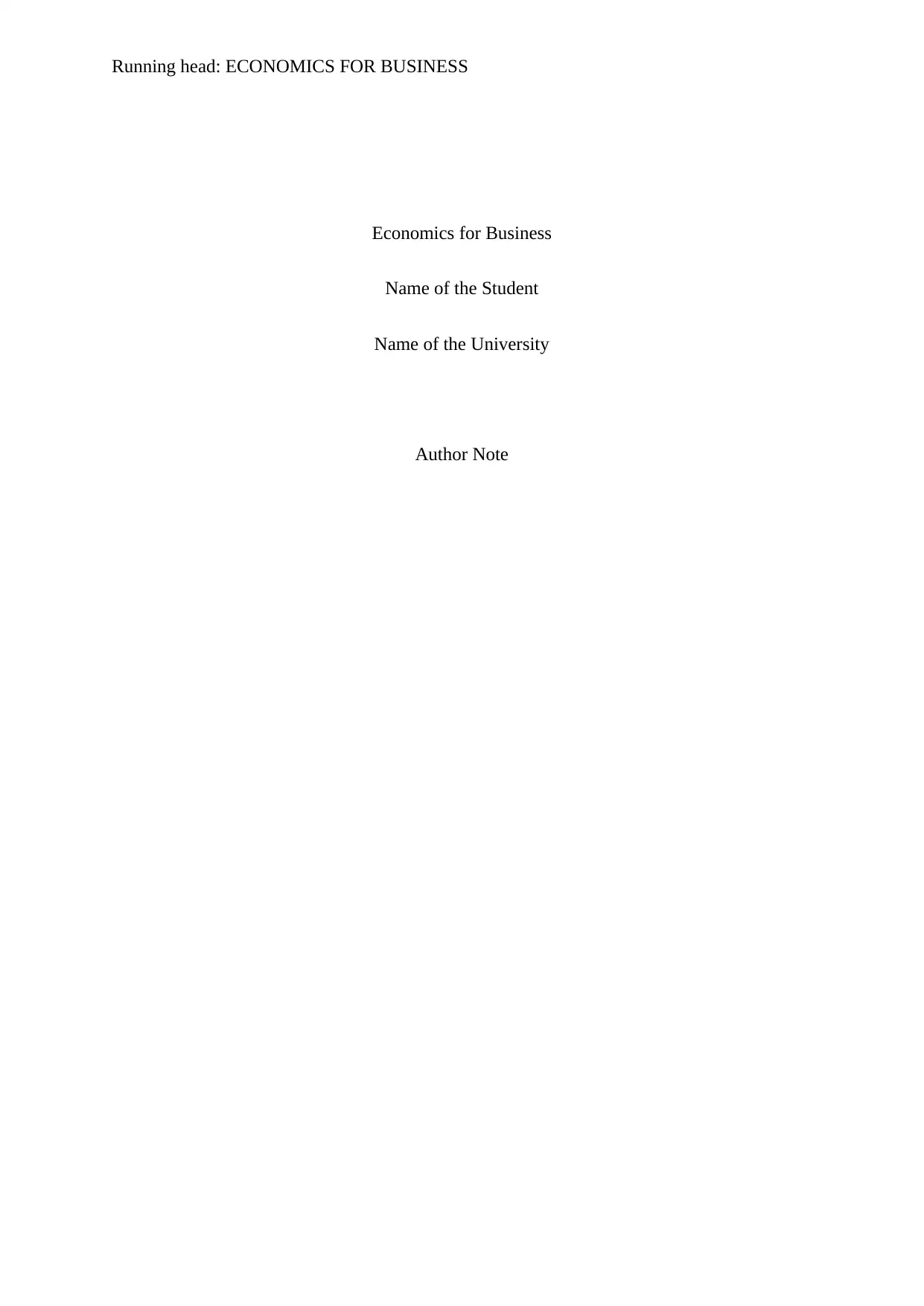
Running head: ECONOMICS FOR BUSINESS
Economics for Business
Name of the Student
Name of the University
Author Note
Economics for Business
Name of the Student
Name of the University
Author Note
Paraphrase This Document
Need a fresh take? Get an instant paraphrase of this document with our AI Paraphraser
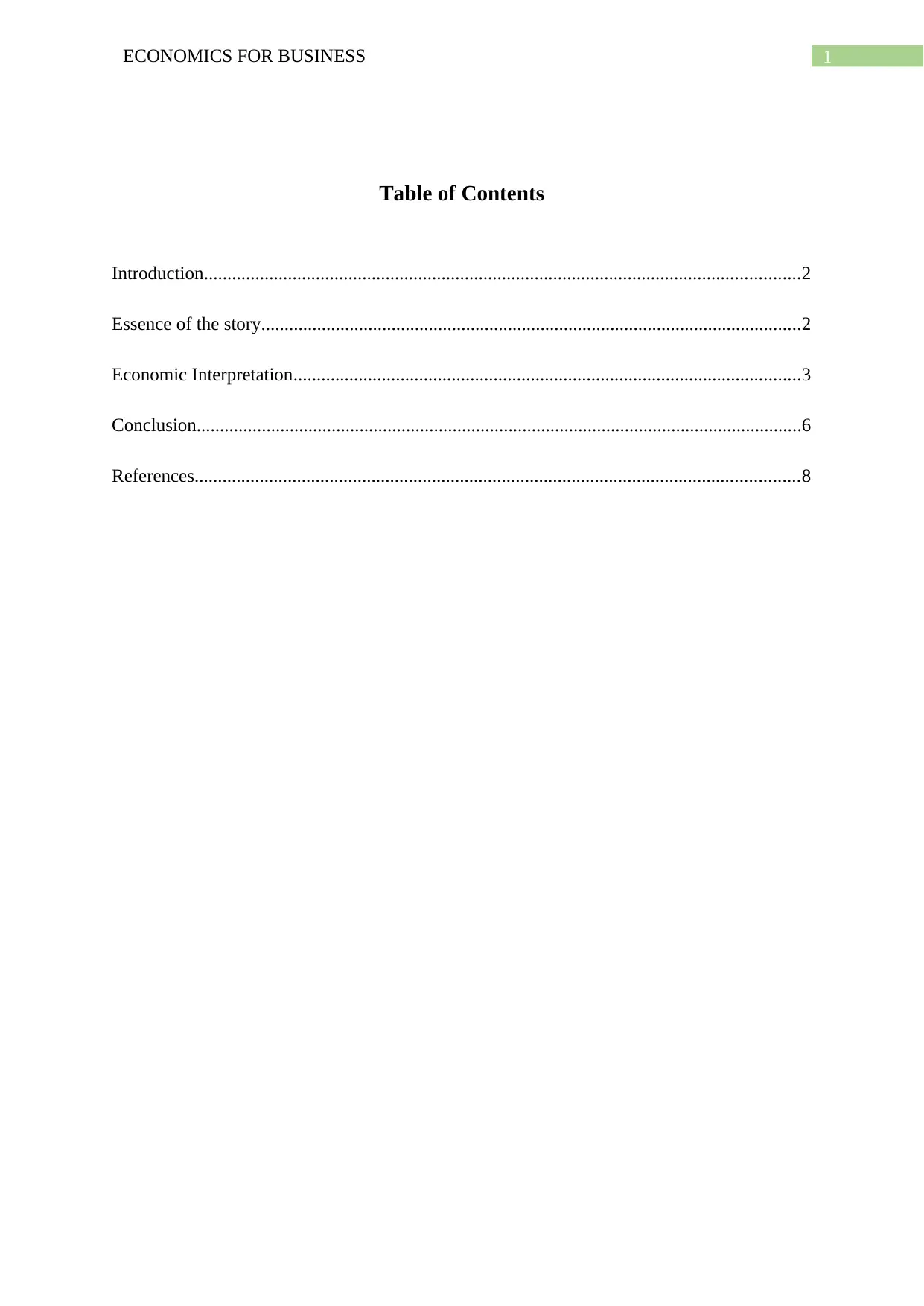
1ECONOMICS FOR BUSINESS
Table of Contents
Introduction................................................................................................................................2
Essence of the story....................................................................................................................2
Economic Interpretation.............................................................................................................3
Conclusion..................................................................................................................................6
References..................................................................................................................................8
Table of Contents
Introduction................................................................................................................................2
Essence of the story....................................................................................................................2
Economic Interpretation.............................................................................................................3
Conclusion..................................................................................................................................6
References..................................................................................................................................8
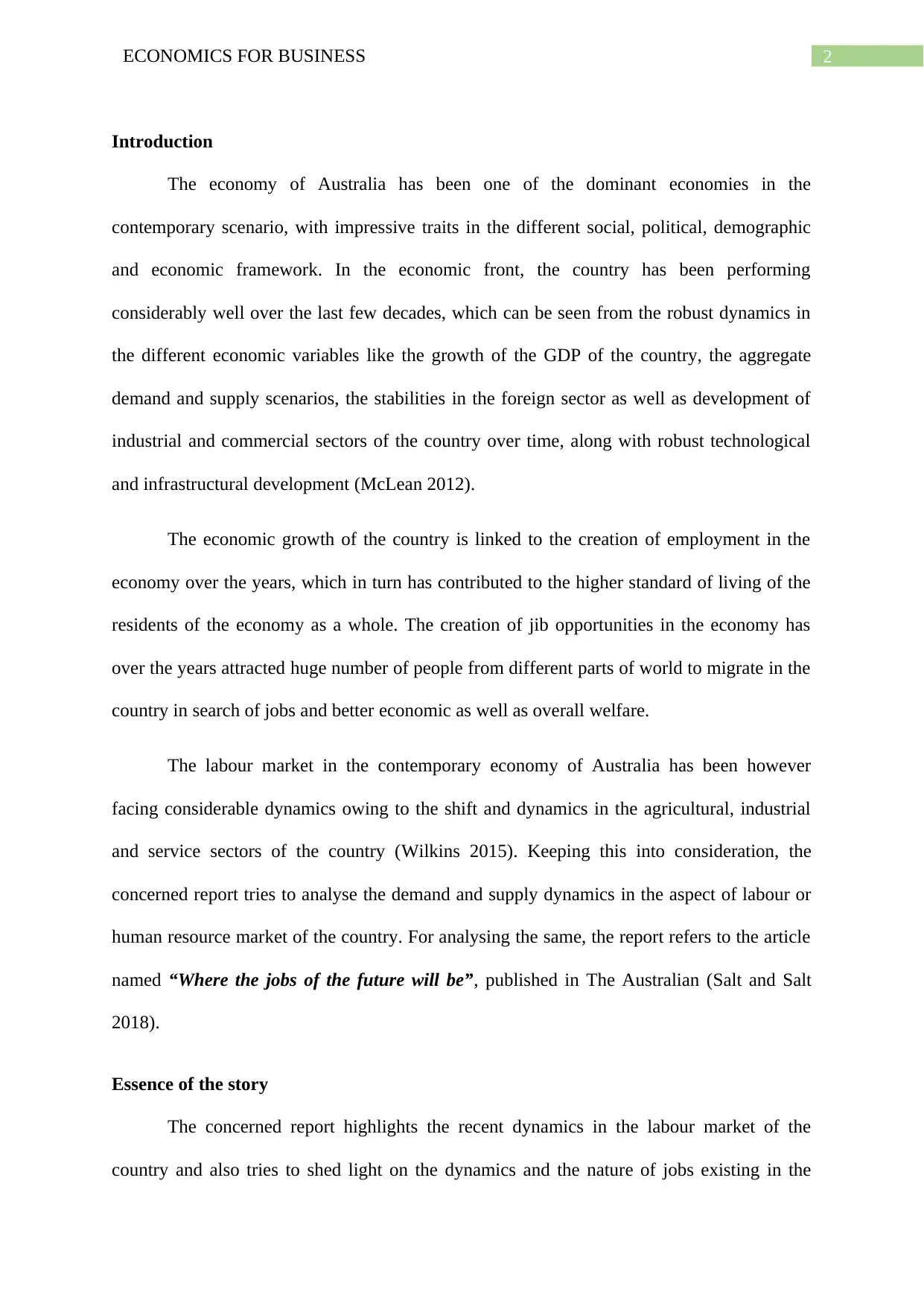
2ECONOMICS FOR BUSINESS
Introduction
The economy of Australia has been one of the dominant economies in the
contemporary scenario, with impressive traits in the different social, political, demographic
and economic framework. In the economic front, the country has been performing
considerably well over the last few decades, which can be seen from the robust dynamics in
the different economic variables like the growth of the GDP of the country, the aggregate
demand and supply scenarios, the stabilities in the foreign sector as well as development of
industrial and commercial sectors of the country over time, along with robust technological
and infrastructural development (McLean 2012).
The economic growth of the country is linked to the creation of employment in the
economy over the years, which in turn has contributed to the higher standard of living of the
residents of the economy as a whole. The creation of jib opportunities in the economy has
over the years attracted huge number of people from different parts of world to migrate in the
country in search of jobs and better economic as well as overall welfare.
The labour market in the contemporary economy of Australia has been however
facing considerable dynamics owing to the shift and dynamics in the agricultural, industrial
and service sectors of the country (Wilkins 2015). Keeping this into consideration, the
concerned report tries to analyse the demand and supply dynamics in the aspect of labour or
human resource market of the country. For analysing the same, the report refers to the article
named “Where the jobs of the future will be”, published in The Australian (Salt and Salt
2018).
Essence of the story
The concerned report highlights the recent dynamics in the labour market of the
country and also tries to shed light on the dynamics and the nature of jobs existing in the
Introduction
The economy of Australia has been one of the dominant economies in the
contemporary scenario, with impressive traits in the different social, political, demographic
and economic framework. In the economic front, the country has been performing
considerably well over the last few decades, which can be seen from the robust dynamics in
the different economic variables like the growth of the GDP of the country, the aggregate
demand and supply scenarios, the stabilities in the foreign sector as well as development of
industrial and commercial sectors of the country over time, along with robust technological
and infrastructural development (McLean 2012).
The economic growth of the country is linked to the creation of employment in the
economy over the years, which in turn has contributed to the higher standard of living of the
residents of the economy as a whole. The creation of jib opportunities in the economy has
over the years attracted huge number of people from different parts of world to migrate in the
country in search of jobs and better economic as well as overall welfare.
The labour market in the contemporary economy of Australia has been however
facing considerable dynamics owing to the shift and dynamics in the agricultural, industrial
and service sectors of the country (Wilkins 2015). Keeping this into consideration, the
concerned report tries to analyse the demand and supply dynamics in the aspect of labour or
human resource market of the country. For analysing the same, the report refers to the article
named “Where the jobs of the future will be”, published in The Australian (Salt and Salt
2018).
Essence of the story
The concerned report highlights the recent dynamics in the labour market of the
country and also tries to shed light on the dynamics and the nature of jobs existing in the
⊘ This is a preview!⊘
Do you want full access?
Subscribe today to unlock all pages.

Trusted by 1+ million students worldwide
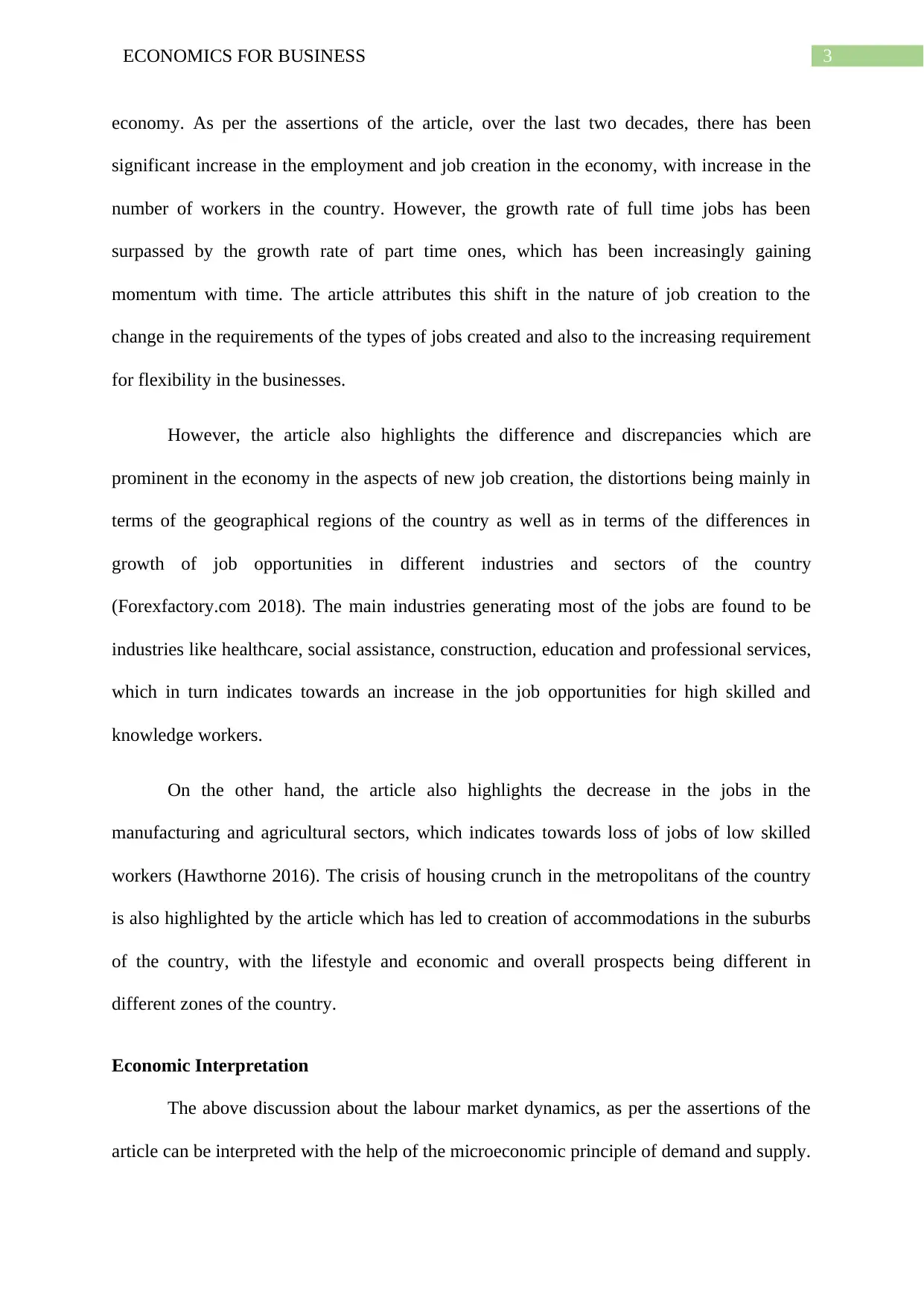
3ECONOMICS FOR BUSINESS
economy. As per the assertions of the article, over the last two decades, there has been
significant increase in the employment and job creation in the economy, with increase in the
number of workers in the country. However, the growth rate of full time jobs has been
surpassed by the growth rate of part time ones, which has been increasingly gaining
momentum with time. The article attributes this shift in the nature of job creation to the
change in the requirements of the types of jobs created and also to the increasing requirement
for flexibility in the businesses.
However, the article also highlights the difference and discrepancies which are
prominent in the economy in the aspects of new job creation, the distortions being mainly in
terms of the geographical regions of the country as well as in terms of the differences in
growth of job opportunities in different industries and sectors of the country
(Forexfactory.com 2018). The main industries generating most of the jobs are found to be
industries like healthcare, social assistance, construction, education and professional services,
which in turn indicates towards an increase in the job opportunities for high skilled and
knowledge workers.
On the other hand, the article also highlights the decrease in the jobs in the
manufacturing and agricultural sectors, which indicates towards loss of jobs of low skilled
workers (Hawthorne 2016). The crisis of housing crunch in the metropolitans of the country
is also highlighted by the article which has led to creation of accommodations in the suburbs
of the country, with the lifestyle and economic and overall prospects being different in
different zones of the country.
Economic Interpretation
The above discussion about the labour market dynamics, as per the assertions of the
article can be interpreted with the help of the microeconomic principle of demand and supply.
economy. As per the assertions of the article, over the last two decades, there has been
significant increase in the employment and job creation in the economy, with increase in the
number of workers in the country. However, the growth rate of full time jobs has been
surpassed by the growth rate of part time ones, which has been increasingly gaining
momentum with time. The article attributes this shift in the nature of job creation to the
change in the requirements of the types of jobs created and also to the increasing requirement
for flexibility in the businesses.
However, the article also highlights the difference and discrepancies which are
prominent in the economy in the aspects of new job creation, the distortions being mainly in
terms of the geographical regions of the country as well as in terms of the differences in
growth of job opportunities in different industries and sectors of the country
(Forexfactory.com 2018). The main industries generating most of the jobs are found to be
industries like healthcare, social assistance, construction, education and professional services,
which in turn indicates towards an increase in the job opportunities for high skilled and
knowledge workers.
On the other hand, the article also highlights the decrease in the jobs in the
manufacturing and agricultural sectors, which indicates towards loss of jobs of low skilled
workers (Hawthorne 2016). The crisis of housing crunch in the metropolitans of the country
is also highlighted by the article which has led to creation of accommodations in the suburbs
of the country, with the lifestyle and economic and overall prospects being different in
different zones of the country.
Economic Interpretation
The above discussion about the labour market dynamics, as per the assertions of the
article can be interpreted with the help of the microeconomic principle of demand and supply.
Paraphrase This Document
Need a fresh take? Get an instant paraphrase of this document with our AI Paraphraser
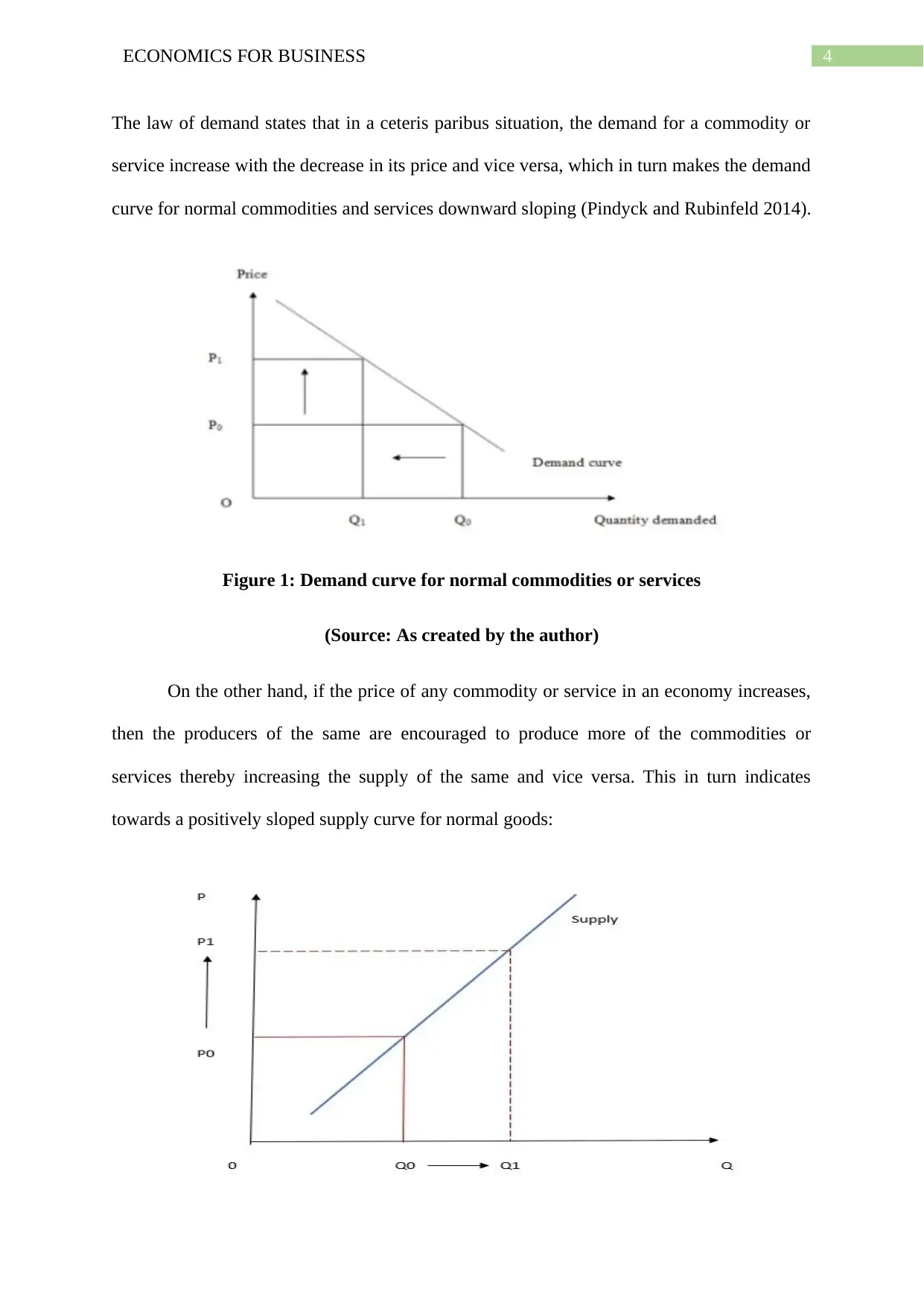
4ECONOMICS FOR BUSINESS
The law of demand states that in a ceteris paribus situation, the demand for a commodity or
service increase with the decrease in its price and vice versa, which in turn makes the demand
curve for normal commodities and services downward sloping (Pindyck and Rubinfeld 2014).
Figure 1: Demand curve for normal commodities or services
(Source: As created by the author)
On the other hand, if the price of any commodity or service in an economy increases,
then the producers of the same are encouraged to produce more of the commodities or
services thereby increasing the supply of the same and vice versa. This in turn indicates
towards a positively sloped supply curve for normal goods:
The law of demand states that in a ceteris paribus situation, the demand for a commodity or
service increase with the decrease in its price and vice versa, which in turn makes the demand
curve for normal commodities and services downward sloping (Pindyck and Rubinfeld 2014).
Figure 1: Demand curve for normal commodities or services
(Source: As created by the author)
On the other hand, if the price of any commodity or service in an economy increases,
then the producers of the same are encouraged to produce more of the commodities or
services thereby increasing the supply of the same and vice versa. This in turn indicates
towards a positively sloped supply curve for normal goods:
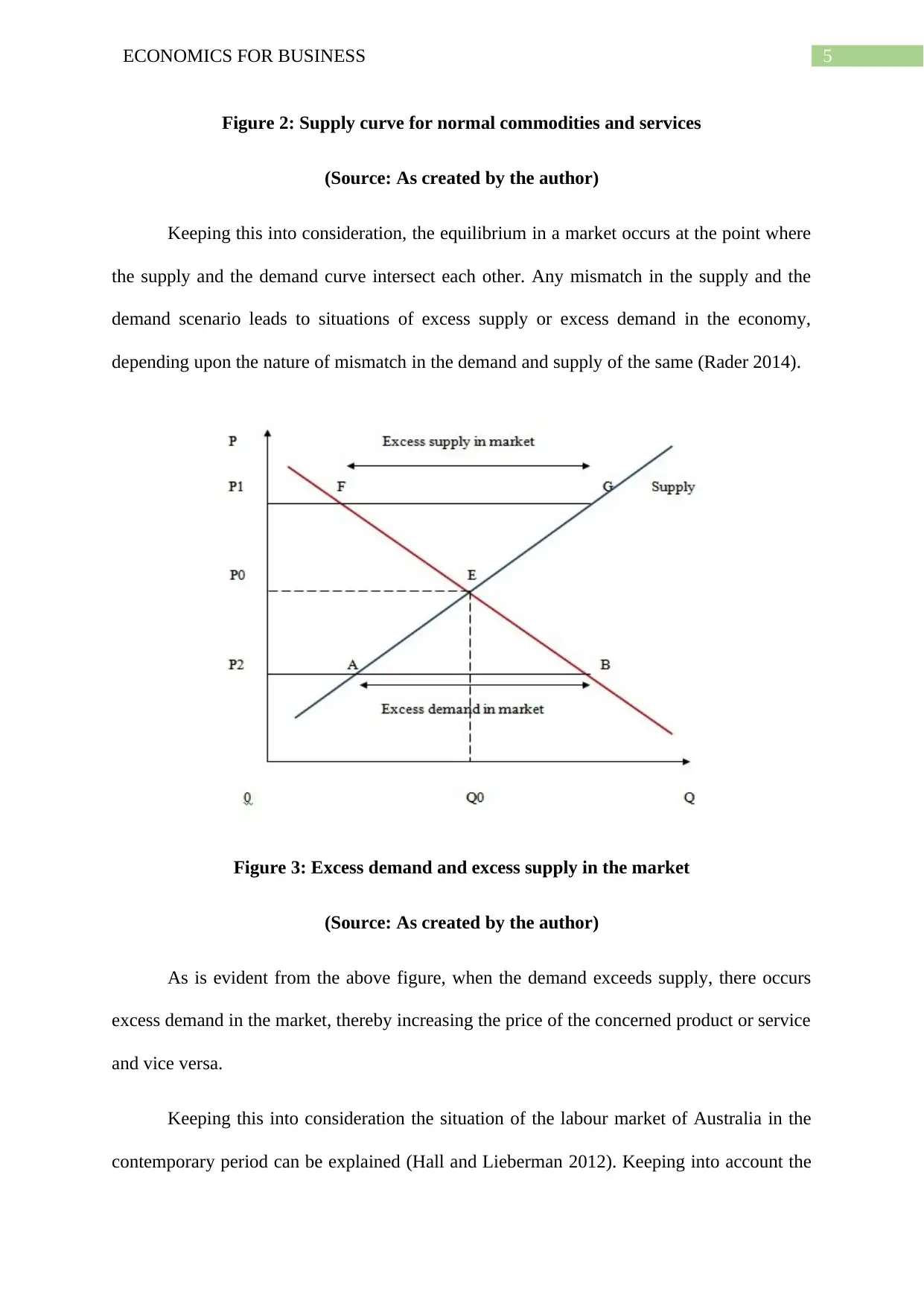
5ECONOMICS FOR BUSINESS
Figure 2: Supply curve for normal commodities and services
(Source: As created by the author)
Keeping this into consideration, the equilibrium in a market occurs at the point where
the supply and the demand curve intersect each other. Any mismatch in the supply and the
demand scenario leads to situations of excess supply or excess demand in the economy,
depending upon the nature of mismatch in the demand and supply of the same (Rader 2014).
Figure 3: Excess demand and excess supply in the market
(Source: As created by the author)
As is evident from the above figure, when the demand exceeds supply, there occurs
excess demand in the market, thereby increasing the price of the concerned product or service
and vice versa.
Keeping this into consideration the situation of the labour market of Australia in the
contemporary period can be explained (Hall and Lieberman 2012). Keeping into account the
Figure 2: Supply curve for normal commodities and services
(Source: As created by the author)
Keeping this into consideration, the equilibrium in a market occurs at the point where
the supply and the demand curve intersect each other. Any mismatch in the supply and the
demand scenario leads to situations of excess supply or excess demand in the economy,
depending upon the nature of mismatch in the demand and supply of the same (Rader 2014).
Figure 3: Excess demand and excess supply in the market
(Source: As created by the author)
As is evident from the above figure, when the demand exceeds supply, there occurs
excess demand in the market, thereby increasing the price of the concerned product or service
and vice versa.
Keeping this into consideration the situation of the labour market of Australia in the
contemporary period can be explained (Hall and Lieberman 2012). Keeping into account the
⊘ This is a preview!⊘
Do you want full access?
Subscribe today to unlock all pages.

Trusted by 1+ million students worldwide
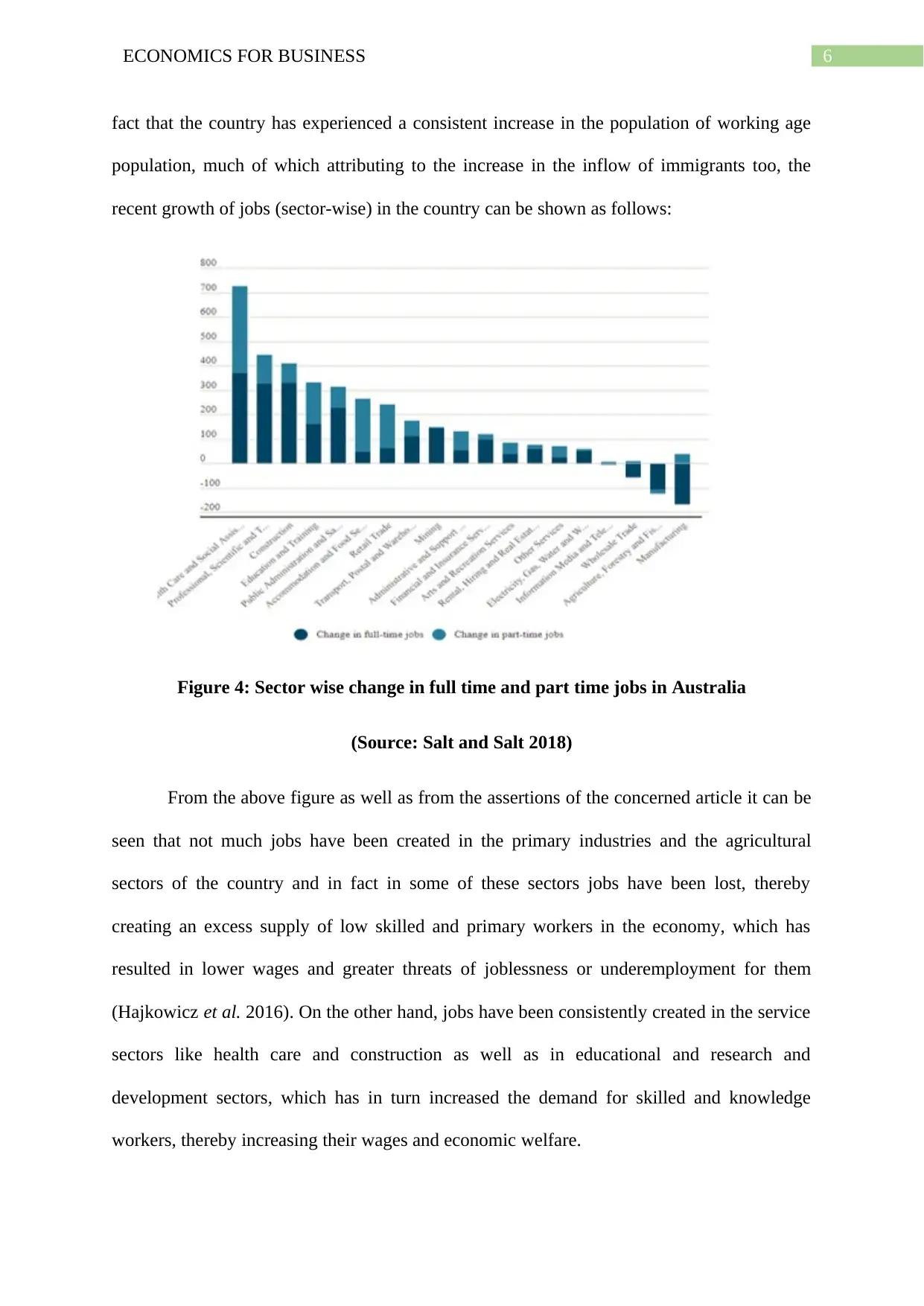
6ECONOMICS FOR BUSINESS
fact that the country has experienced a consistent increase in the population of working age
population, much of which attributing to the increase in the inflow of immigrants too, the
recent growth of jobs (sector-wise) in the country can be shown as follows:
Figure 4: Sector wise change in full time and part time jobs in Australia
(Source: Salt and Salt 2018)
From the above figure as well as from the assertions of the concerned article it can be
seen that not much jobs have been created in the primary industries and the agricultural
sectors of the country and in fact in some of these sectors jobs have been lost, thereby
creating an excess supply of low skilled and primary workers in the economy, which has
resulted in lower wages and greater threats of joblessness or underemployment for them
(Hajkowicz et al. 2016). On the other hand, jobs have been consistently created in the service
sectors like health care and construction as well as in educational and research and
development sectors, which has in turn increased the demand for skilled and knowledge
workers, thereby increasing their wages and economic welfare.
fact that the country has experienced a consistent increase in the population of working age
population, much of which attributing to the increase in the inflow of immigrants too, the
recent growth of jobs (sector-wise) in the country can be shown as follows:
Figure 4: Sector wise change in full time and part time jobs in Australia
(Source: Salt and Salt 2018)
From the above figure as well as from the assertions of the concerned article it can be
seen that not much jobs have been created in the primary industries and the agricultural
sectors of the country and in fact in some of these sectors jobs have been lost, thereby
creating an excess supply of low skilled and primary workers in the economy, which has
resulted in lower wages and greater threats of joblessness or underemployment for them
(Hajkowicz et al. 2016). On the other hand, jobs have been consistently created in the service
sectors like health care and construction as well as in educational and research and
development sectors, which has in turn increased the demand for skilled and knowledge
workers, thereby increasing their wages and economic welfare.
Paraphrase This Document
Need a fresh take? Get an instant paraphrase of this document with our AI Paraphraser
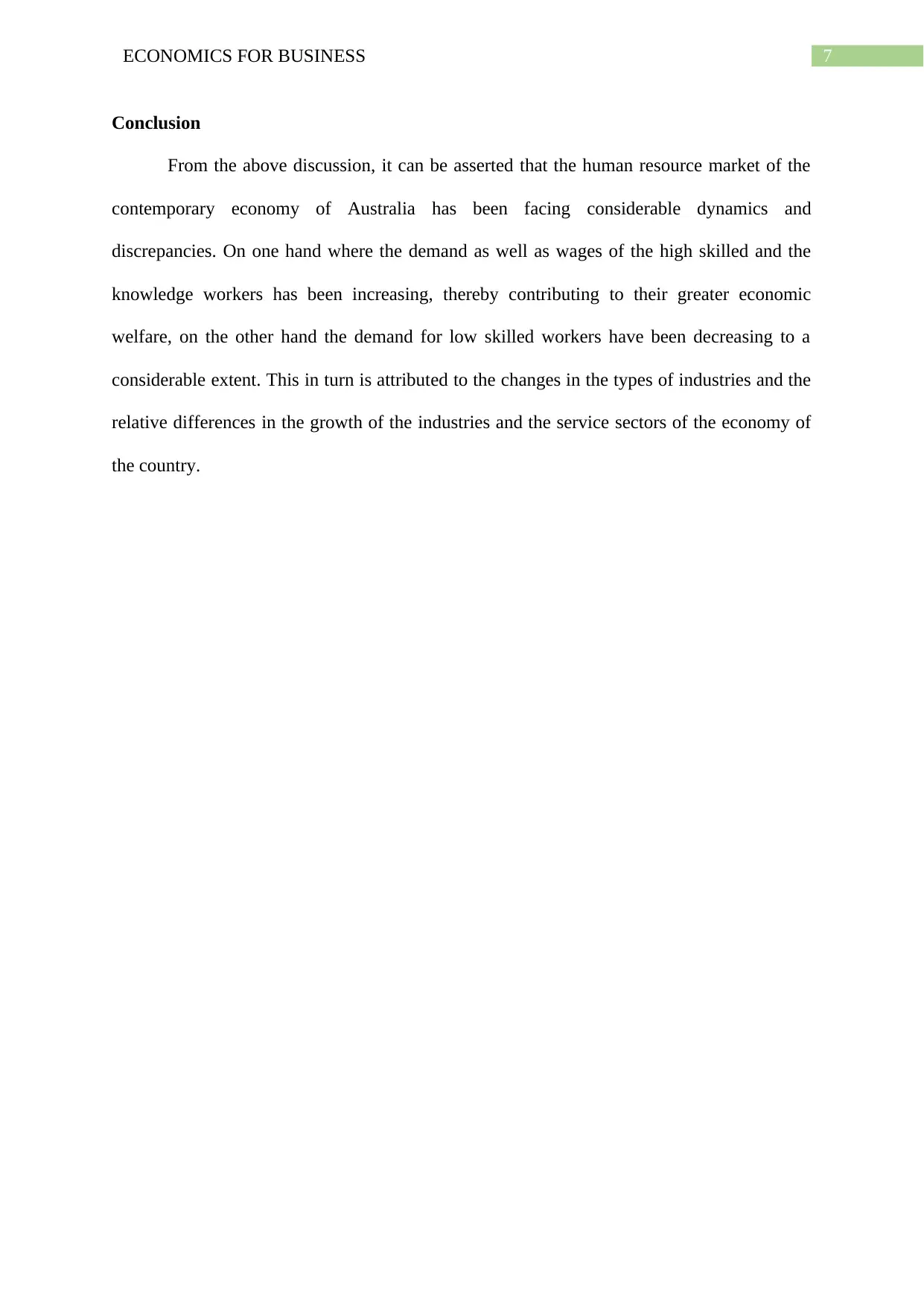
7ECONOMICS FOR BUSINESS
Conclusion
From the above discussion, it can be asserted that the human resource market of the
contemporary economy of Australia has been facing considerable dynamics and
discrepancies. On one hand where the demand as well as wages of the high skilled and the
knowledge workers has been increasing, thereby contributing to their greater economic
welfare, on the other hand the demand for low skilled workers have been decreasing to a
considerable extent. This in turn is attributed to the changes in the types of industries and the
relative differences in the growth of the industries and the service sectors of the economy of
the country.
Conclusion
From the above discussion, it can be asserted that the human resource market of the
contemporary economy of Australia has been facing considerable dynamics and
discrepancies. On one hand where the demand as well as wages of the high skilled and the
knowledge workers has been increasing, thereby contributing to their greater economic
welfare, on the other hand the demand for low skilled workers have been decreasing to a
considerable extent. This in turn is attributed to the changes in the types of industries and the
relative differences in the growth of the industries and the service sectors of the economy of
the country.
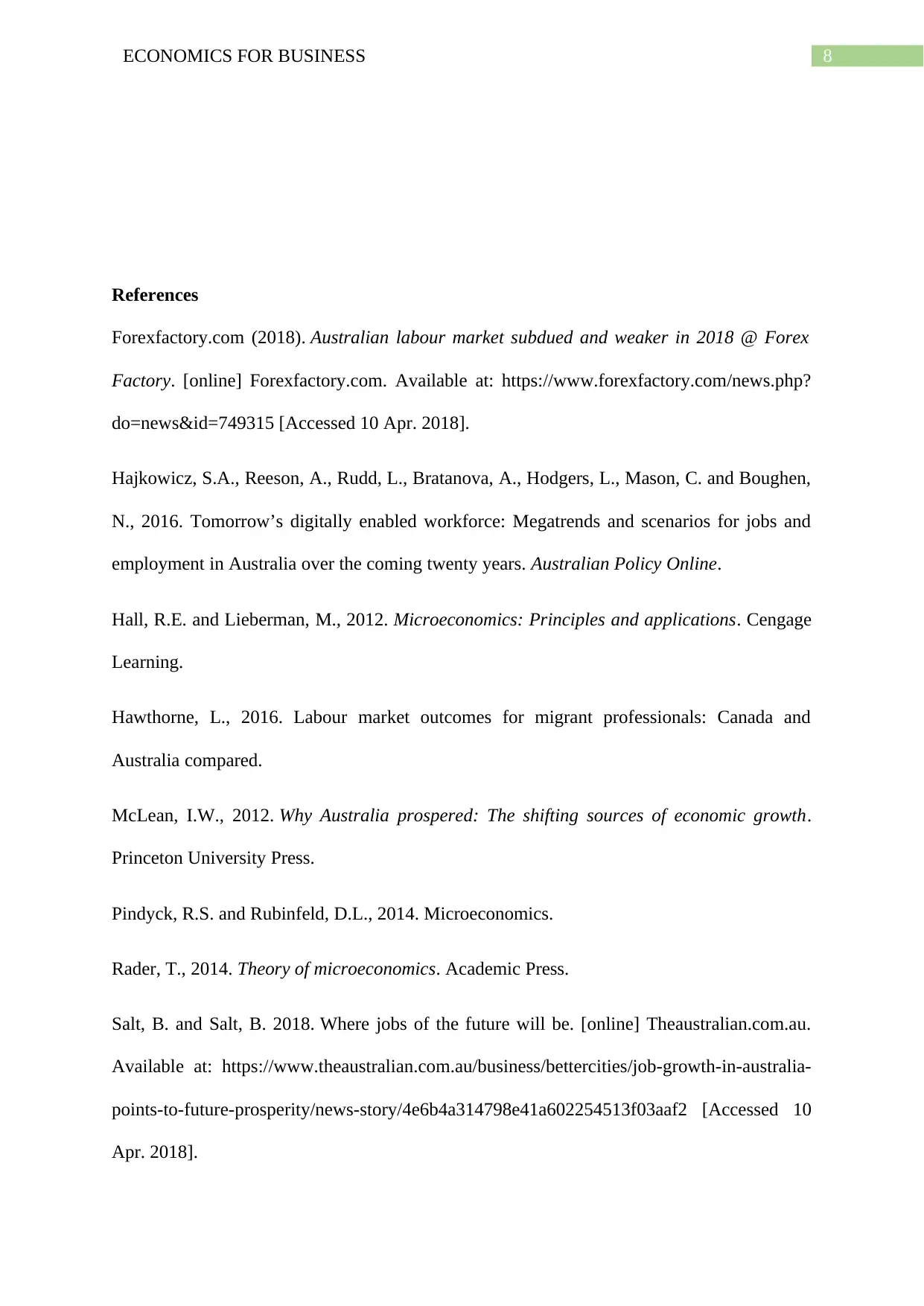
8ECONOMICS FOR BUSINESS
References
Forexfactory.com (2018). Australian labour market subdued and weaker in 2018 @ Forex
Factory. [online] Forexfactory.com. Available at: https://www.forexfactory.com/news.php?
do=news&id=749315 [Accessed 10 Apr. 2018].
Hajkowicz, S.A., Reeson, A., Rudd, L., Bratanova, A., Hodgers, L., Mason, C. and Boughen,
N., 2016. Tomorrow’s digitally enabled workforce: Megatrends and scenarios for jobs and
employment in Australia over the coming twenty years. Australian Policy Online.
Hall, R.E. and Lieberman, M., 2012. Microeconomics: Principles and applications. Cengage
Learning.
Hawthorne, L., 2016. Labour market outcomes for migrant professionals: Canada and
Australia compared.
McLean, I.W., 2012. Why Australia prospered: The shifting sources of economic growth.
Princeton University Press.
Pindyck, R.S. and Rubinfeld, D.L., 2014. Microeconomics.
Rader, T., 2014. Theory of microeconomics. Academic Press.
Salt, B. and Salt, B. 2018. Where jobs of the future will be. [online] Theaustralian.com.au.
Available at: https://www.theaustralian.com.au/business/bettercities/job-growth-in-australia-
points-to-future-prosperity/news-story/4e6b4a314798e41a602254513f03aaf2 [Accessed 10
Apr. 2018].
References
Forexfactory.com (2018). Australian labour market subdued and weaker in 2018 @ Forex
Factory. [online] Forexfactory.com. Available at: https://www.forexfactory.com/news.php?
do=news&id=749315 [Accessed 10 Apr. 2018].
Hajkowicz, S.A., Reeson, A., Rudd, L., Bratanova, A., Hodgers, L., Mason, C. and Boughen,
N., 2016. Tomorrow’s digitally enabled workforce: Megatrends and scenarios for jobs and
employment in Australia over the coming twenty years. Australian Policy Online.
Hall, R.E. and Lieberman, M., 2012. Microeconomics: Principles and applications. Cengage
Learning.
Hawthorne, L., 2016. Labour market outcomes for migrant professionals: Canada and
Australia compared.
McLean, I.W., 2012. Why Australia prospered: The shifting sources of economic growth.
Princeton University Press.
Pindyck, R.S. and Rubinfeld, D.L., 2014. Microeconomics.
Rader, T., 2014. Theory of microeconomics. Academic Press.
Salt, B. and Salt, B. 2018. Where jobs of the future will be. [online] Theaustralian.com.au.
Available at: https://www.theaustralian.com.au/business/bettercities/job-growth-in-australia-
points-to-future-prosperity/news-story/4e6b4a314798e41a602254513f03aaf2 [Accessed 10
Apr. 2018].
⊘ This is a preview!⊘
Do you want full access?
Subscribe today to unlock all pages.

Trusted by 1+ million students worldwide
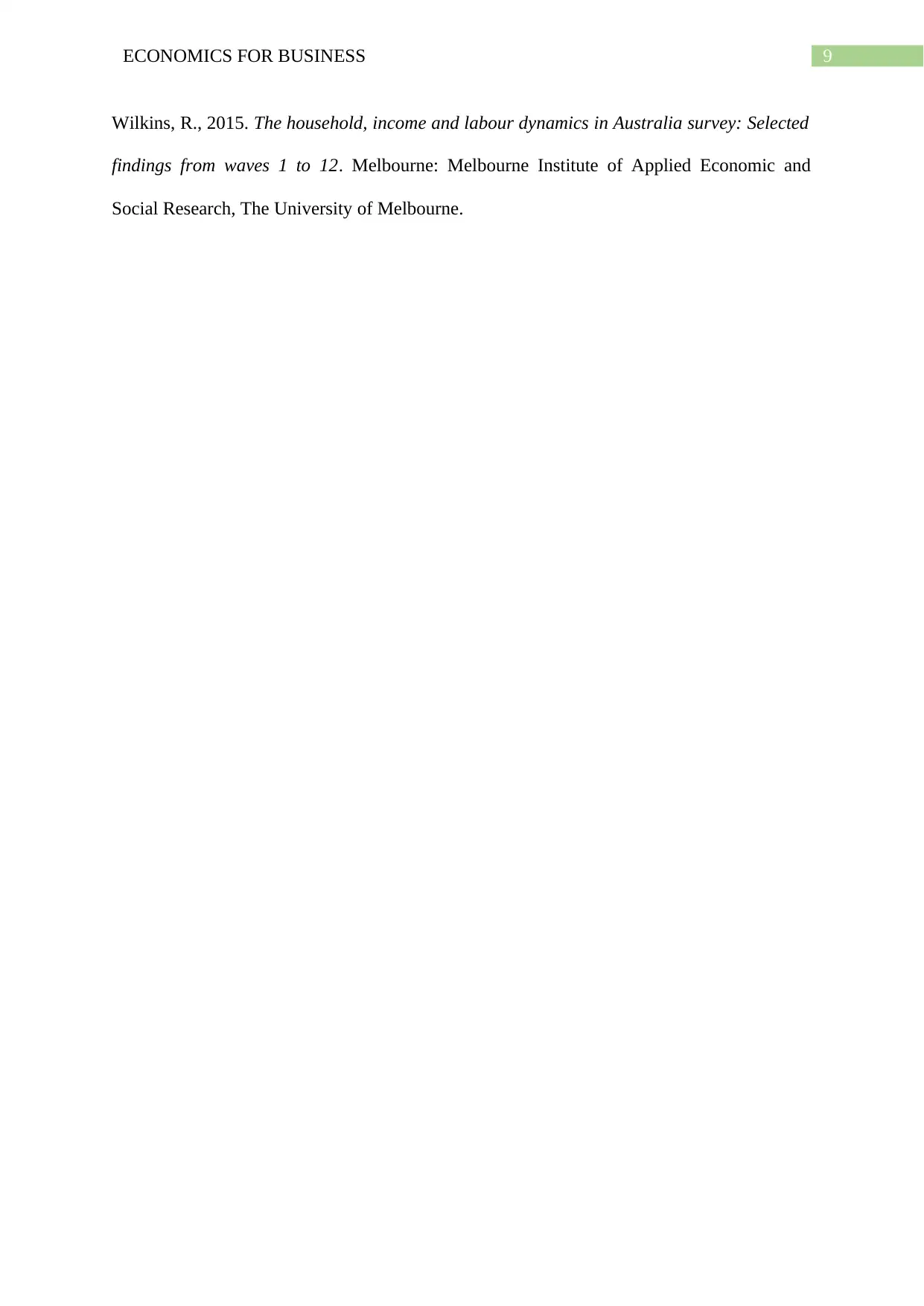
9ECONOMICS FOR BUSINESS
Wilkins, R., 2015. The household, income and labour dynamics in Australia survey: Selected
findings from waves 1 to 12. Melbourne: Melbourne Institute of Applied Economic and
Social Research, The University of Melbourne.
Wilkins, R., 2015. The household, income and labour dynamics in Australia survey: Selected
findings from waves 1 to 12. Melbourne: Melbourne Institute of Applied Economic and
Social Research, The University of Melbourne.
1 out of 10
Related Documents
Your All-in-One AI-Powered Toolkit for Academic Success.
+13062052269
info@desklib.com
Available 24*7 on WhatsApp / Email
![[object Object]](/_next/static/media/star-bottom.7253800d.svg)
Unlock your academic potential
Copyright © 2020–2025 A2Z Services. All Rights Reserved. Developed and managed by ZUCOL.





